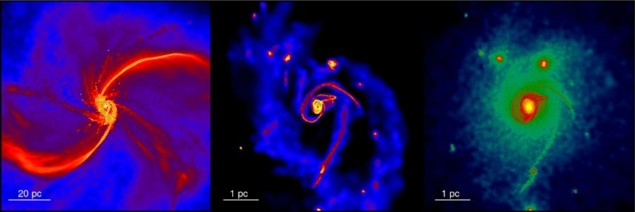
Lurking at the centre of nearly every galaxy and gobbling up stars in their vicinity, supermassive black holes are a truly menacing feature of the universe. Now, an international team of astronomers claims to have solved the mystery of how legions of these galactic monsters were born during the early history of the universe.
Supermassive black holes (SMBH) are thousands or even millions of times more massive than our Sun. We know that they exist from the impact they have on their surroundings: causing nearby stars to orbit galactic centres at breakneck speeds, for instance. Once SMBHs reach a critical size they can transform into quasars, which are extremely bright objects as small as a star but as luminous as an entire galaxy. But the relative abundance of quasars in the first billion years of the universe has puzzled astrophysicists.
This is because the “seed” for a blackhole is believed to take at least 108 years to form and then several more billion years to grow into a SMBH, followed in some cases by quasars. This was based on the assumption that SMBHs form in a similar way to stellar-mass black holes, marking the final phase in the lifespan of massive stars that have exhausted all their fuel for fusion.
Galaxies merging
Lucio Mayer at the University of Zurich, working with colleagues in Chile and the US, now offers an alternative exploration for how these SMBHs formed. The group proposes that the right conditions for black hole formation could have been created by the merging of two or more galaxies during their primordial stages when they were still emerging from vast clouds of dust.
Our result shows that big structures – both galaxies and massive black holes – build up quickly in the history of the universe Stelios Kazantzidis
Using computer simulations, involving more than 3 million computing hours, Mayer’s team found that when two young galaxies come together it can cause dust to spiral rapidly towards to a confluence at the centre. For galaxies above a critical size, more than 100 million solar masses of dust can be channelled towards the centre within just 100,000 years, creating a dense cloud in the centre.
“The high concentration of gas at the disk-like nuclei of the interacting galaxies causes tidal forces that cause the gas to effectively lose angular momentum and spiral to the centre,” explains Mayer. Shortly after this, the core of the cloud collapsed to form the seed of a black hole, and after 108 years the supermassive blackhole had grown to a billion solar masses.
Contradicts prevailing wisdom
If the findings are accepted by the community, they will turn around the prevailing wisdom among astronomers that galaxies evolved hierarchically – that is, gravity drew small bits of matter together first, and those small bits gradually came together to form larger structures.
“Our result shows that big structures – both galaxies and massive black holes – build up quickly in the history of the universe,” says Stelios Kazantzidis, another member of the team based at Ohio State University. “[The findings] add a new milestone to the important realization of how structure forms in the universe.”
The model does not, however, explain how smaller galaxies such as our own have evolved to contain an SMBH at their centre. In the case of the Milky Way, Mayer speculates that a similar gas-consuming process could have occurred later in its history when it had reached a critical mass after three to four billion years.
Further testing required
Andrew Jaffe, an astrophysicist at Imperial College London agrees that it would be useful to extend this model to cover a wider range of galaxy types. “As a further test of their modelling, it would be very nice to see whether they reproduce the dynamics of merging galaxies in other, more well-studied, situations – such as mergers of modern-day galaxies.”
The research may aid astronomers who are searching the skies for gravitatational waves, which would provide direct evidence of general relativity. According to Einstein’s theory, any ancient galaxy mergers would have created massive gravitational waves – ripples in the space–time continuum – the remnants of which should still be visible today.
Over the coming decade, several space-based missions have been planned to search for these elusive phenomena using interferometry equipment. “As the authors correctly point out, the way their blackholes form from direct collapsing has a profound impact on the gravitational wave signal expected in missions such as LISA,” says Francesco Haardt an astronomer at the University of Insubria.
The Laser Interferometer Space Antenna (LISA) is a joint mission between NASA and the European Space Agency scheduled for launch in 2025.
This research is described in Nature.




